South Korea 2010 "The Age of Dinosaurs - Triassic Period"
| <prev | back to index | next> |
| Issue Date | 05.08.2010 |
| ID | Michel: 2780-2783; Scott: 2340a-d; Stanley Gibbons: 3119-3121; Yvert et Tellier: 2568-2571; Category: pR |
| Design | Designer - Jiwon MO |
| Stamps in set | 4 |
| Value |
250 Won - Coelophysis 250 Won - Herrerasaurus 340 Won - Plateosaurus 340 Won - Riojasaurus |
| Emission/Type | commemorative |
| Issue place | Seoul |
| Size (width x height) | stamps: 50mm X 33mm, Sheet: 250mm x 150mm |
| Layout | Sheet of 12 stamps |
| Products | FDC x1 |
| Paper | White Unwatermarked |
| Perforation | 13 |
| Print Technique | Offset, six colors + Intaglio, one color |
| Printed by | Korea Minting and Security Printing Corporation(KOMSCO) |
| Quantity | 540.000 stamps each |
| Issuing Authority | Korea Post |
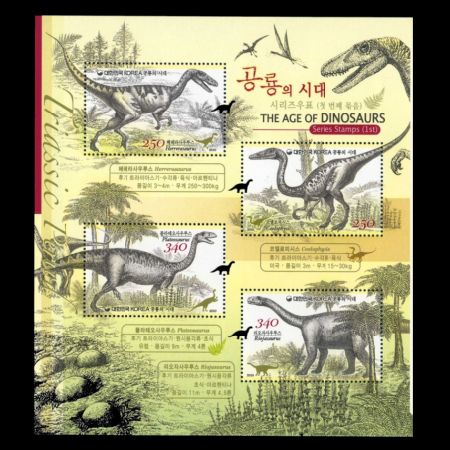
On August 5th 2010, Korean Post issued the set "The Age of Dinosaurs" - the first four stamps in a three-year series. This series covers Mesozoic Era and features dinosaurs found around the world. Every issue show four dinosaurs and cover one period of the Mesozoic Era:
- "Triassic Period" - 05.08.2010
- "Jurassic Period" - 11.08.2011
- "Cretaceous Period" - 08.08.2012
This fascinating animal appeared hundreds of millions of years ago to dominate life on earth for 160 million years only to abruptly go extinct. During the next three years, dinosaurs of each epochal period (the Triassic, Jurassic, and Cretaceous periods of the Mesozoic Era) were introduced.
Dinosaurs first appeared during the Triassic Period which lasted from 245 million years to 208 million years ago. Approximately at this time, all the continents on the earth were clumped together, with the continental areas being dry and rivers and seaside swarmed with ferns, tall coniferous trees, ginkgoes and cycads.
Note: This set is the first one with perforations shaped like the silhouette of dinosaurs.
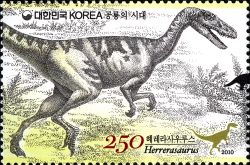 |
| Herrerasaurus dinosaur on stamp of South Korea 2010, MiNr.: 2780, Scott: 2340a. |
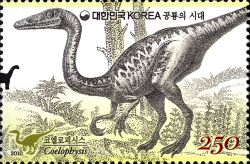 |
| Coelophysis dinosaur on stamp of South Korea 2010, MiNr.: 2781, Scott: 2340b. |
Coelophysis as a quick and agile dinosaur, its front legs were very short and its body except for the tail was a little bigger than a turkey. In 1947, hundreds of Coelophysis fossils were found in Ghost Ranch, New Mexico, USA . Unlike other large, carnivorous dinosaurs, Coelophysis seemed to have lived in groups, moving in herds. Its body was 3 m at longest and weighed 15-30 kg.
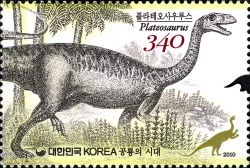 |
| Plateosaurus dinosaur on stamp of South Korea 2010, MiNr.: 2782, Scott: 2340c. |
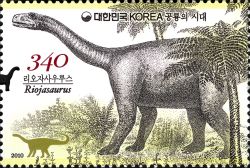 |
| Riojasaurus dinosaur on stamp of South Korea 2010, MiNr.: 2783, Scott: 2340d. |
Riojasaurus with legs as thick and robust as an elephant and a long neck, had a non-proportionally longer tail, which seemed to have been used either for balance or as a weapon. It grabbed its food using five, long, front toes. Like other herbivorous dinosaurs, it had spoon-shaped teeth. It stood 11 m long and weighed 4.5 tons.
Riojasaurus (meaning "Rioja lizard") named after La Rioja Province in Argentina where it was found in the Los Colorados Formation in the Ischigualasto-Villa Union Basin by Jose Bonaparte.
Products and associated philatelic items
| FDC | ||
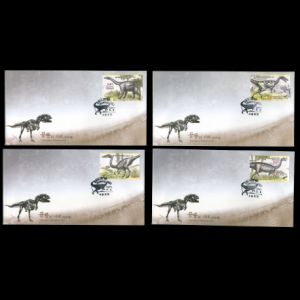 |
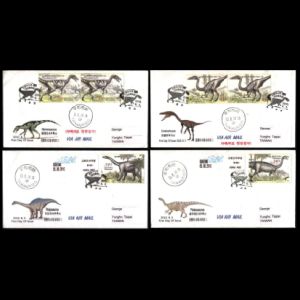 |
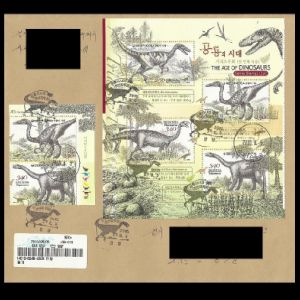 |
| First-Day-of-Issue Postmark | Mini-Sheet | Boklet |
 |
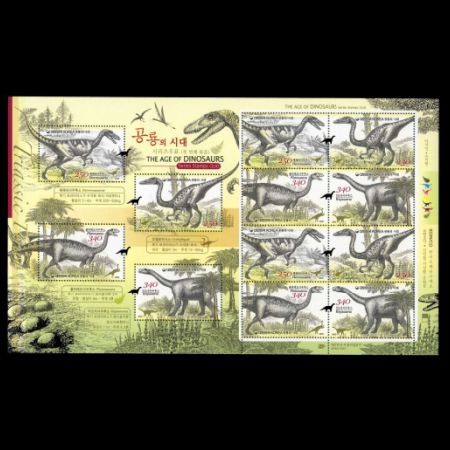 |
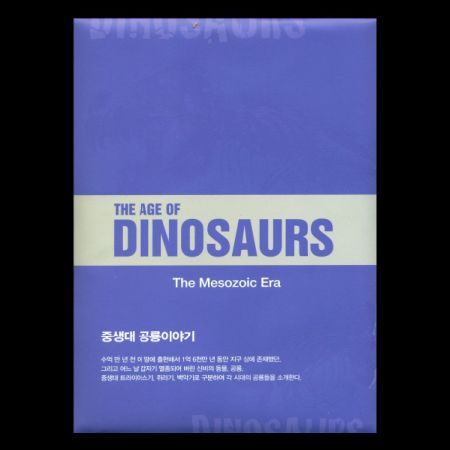 |
| Example of circulated covers | ||
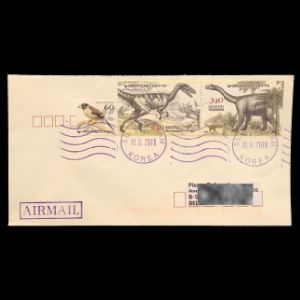 |
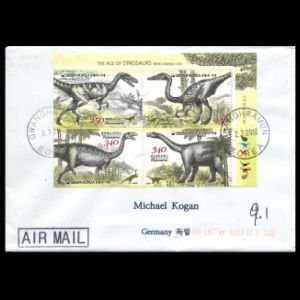 |
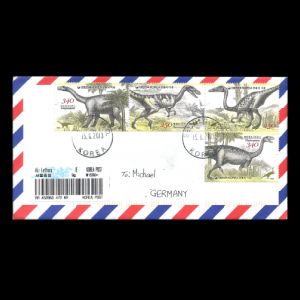 |
References:

|
- Technical details and short press releases:
Korean stamp postal services, colnect.
Acknowledgements:
- Many thanks to Dr. Peter Voice from Department of Geological and Environmental Sciences, Western Michigan University, for review of a draft of this article.
| <prev | back to index | next> |